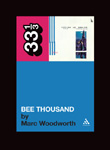| Comments |
Synopsis
An in-depth analysis of the most infamous lo-fi album of the 90s.
Description
Marc Woodworth's book covers the album�s long and unorthodox period of writing, recording, sequencing, and editing. It includes interviews with members of the band, manager Pete Jamison, web-master and GBV historian Rich Turiel and Robert Griffin of Scat Records. At least sixty-five songs were recorded and considered for the album and five distinct concepts were rejected before the band hit upon the records final form. One late version, very nearly released, contained only a few of Bee Thousand�s definitive songs.
The rest were left out and nearly ended up in the boxes of cassette out-takes cluttering up Robert Pollard�s basement. The story of Guided By Voices transformation from an occasional and revolving group of complete unknowns to indie-rock heroes is very much part of the story behind the making of Bee Thousand.
In addition to providing a central account of how the record was made, Woodworth devotes a substantial chapter to the album�s lyrics. Robert Pollard�s lyrics are described by critics, when they�re described at all, as a brand of tossed-off surrealism, as if his verbal sensibility is somehow incidental to the songs themselves. Nothing could be further from the truth. Woodworth offers a sustained discussion of Pollard�s work as a writer of often sublime, beautiful, and very human lyrics.
The third key section of the book covers aesthetics. Woodworth considers the great appeal of the do-it-yourself nature of Bee Thousand and reflects on the larger importance of the strain of alternative rock for which this record is a touchstone.
Author: Marc Woodworth
Marc Woodworth is the author of Solo: Women Singer-Songwriters in their Own Words (Dell, 1998) which contained transcribed and edited first-person narratives derived from his interviews with nineteen artists like Ani DiFranco, Sheryl Crow, and Cassandra Wilson. He is also the author of a volume of poetry, Arcade (Grove Press, 2002), and is the editor of a high-culture quarterly, Salmagundi.
|
|
